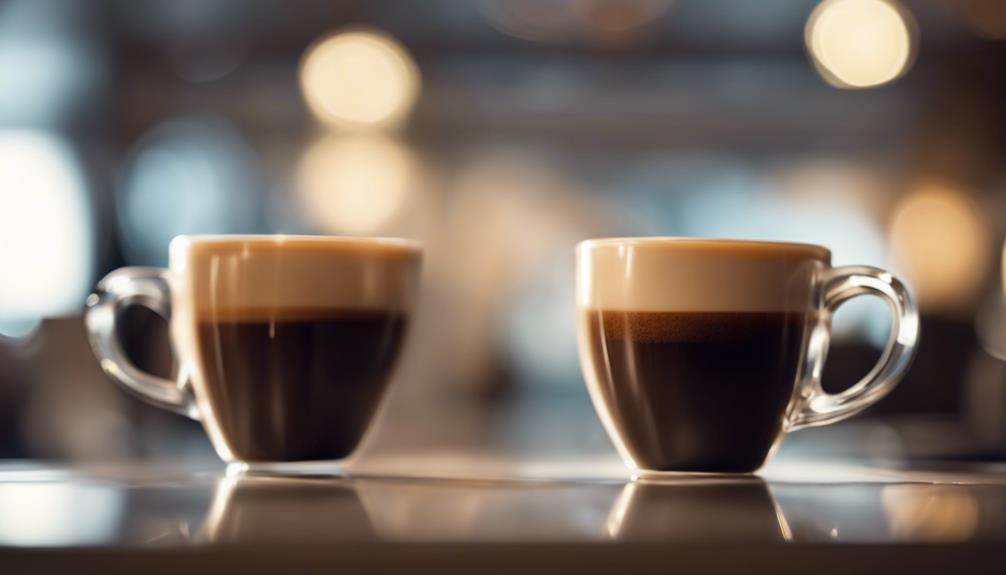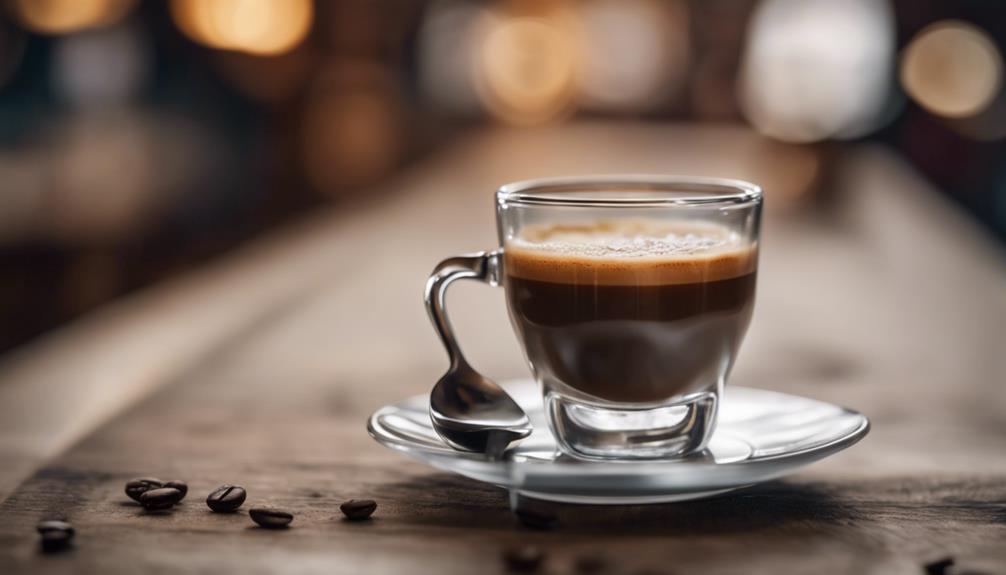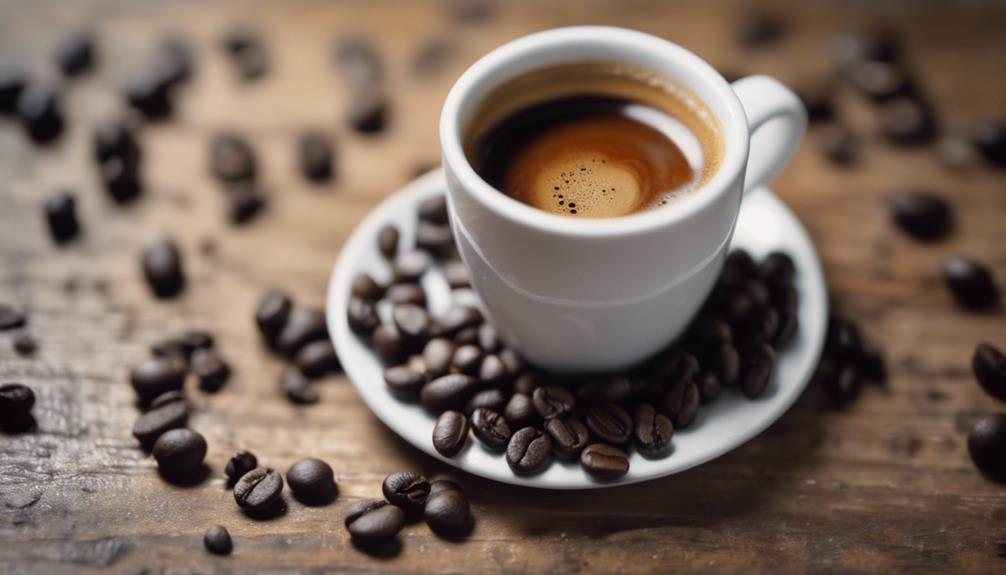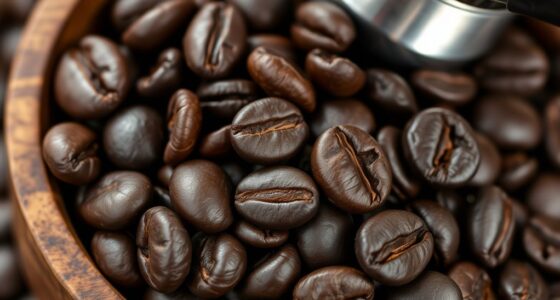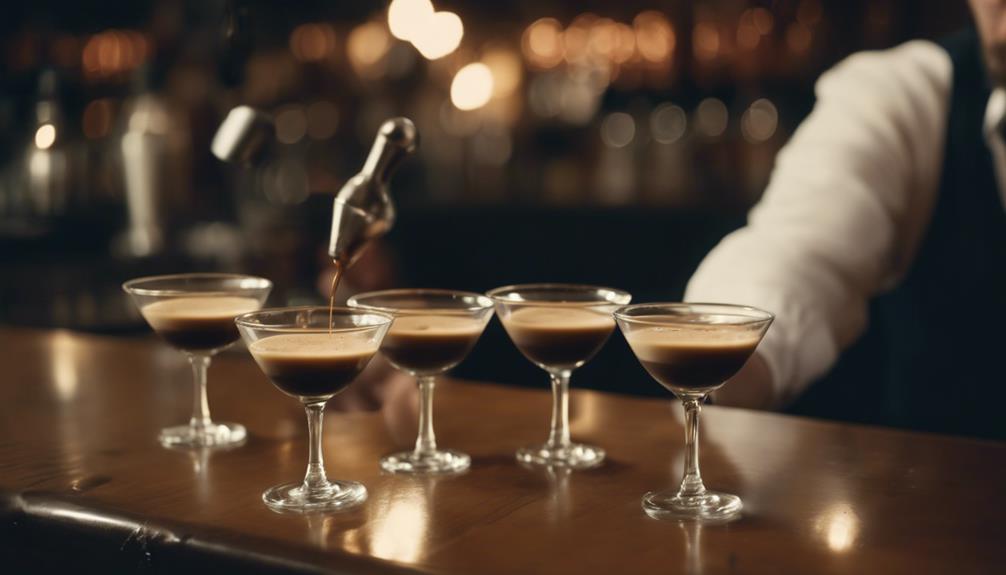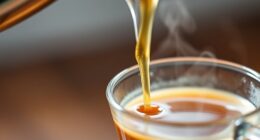When deciding between Lungo and Espresso, it’s important to consider these key differences: Lungo offers a balanced, mild coffee flavor with roasty undertones and a less concentrated brew, while Espresso boasts intense boldness and a rich aroma. Lungo requires a longer extraction time, using more water, resulting in a lighter taste compared to the robust, concentrated Espresso. Espresso features a thick crema, and its high-pressure brewing process creates bold flavors. Lungo’s extended extraction process brings out nuanced flavors. Understanding these distinctions is crucial for choosing your preferred coffee experience.
Key Takeaways
- Lungo has a higher water-to-coffee ratio than Espresso.
- Espresso is known for its bold and intense flavor.
- Lungo offers a milder taste due to extended extraction.
- Espresso has a 1:2 brew ratio, while Lungo has 1:4.
- Lungo shots generally contain more caffeine than Espresso.
Flavor Profiles
If you prefer a balanced and mild coffee flavor, Lungo may be more to your liking compared to the intense and bold taste of espresso. Lungo offers a less concentrated brew with a roasty undertone and slight bitterness, in contrast to the rich aroma of espresso.
The extended extraction time of around one minute for Lungo allows for a more nuanced flavor profile to develop, resulting in a lighter-colored and less viscous coffee. The flavors in Lungo extract differently due to this longer extraction time, making it a preferred choice for those seeking a milder coffee experience.
The 1:4 brew ratio of Lungo contributes to its distinct flavor, catering to individuals who enjoy a smoother and less intense coffee taste. In summary, Lungo's flavor profile is characterized by its balanced and roasty notes, offering a mild alternative to the bold and concentrated taste of espresso.
Brewing Process
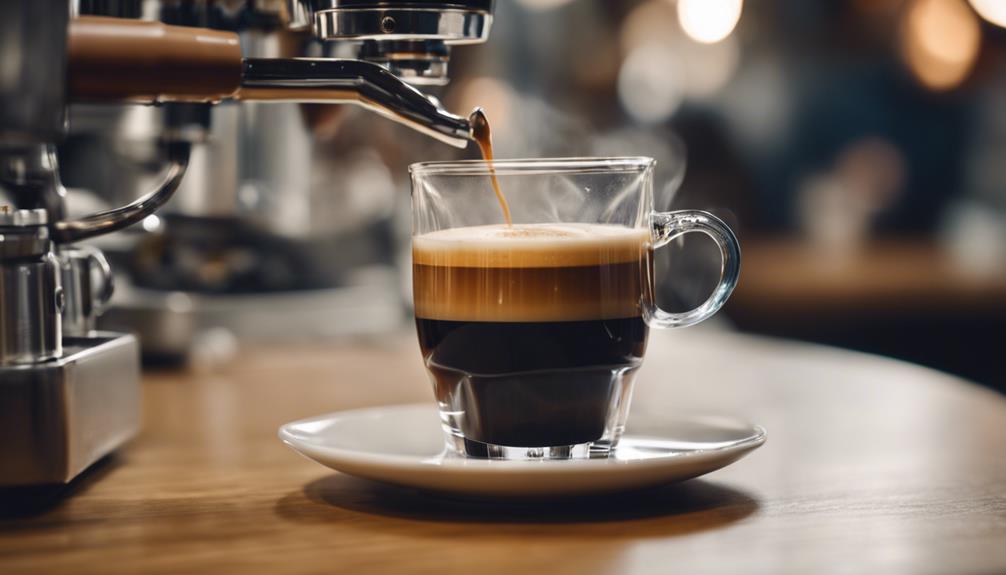
To understand the difference in the brewing process between Lungo and Espresso, it's important to highlight the key variations in their preparation methods.
Here are some key differences in the brewing process:
- Brewing time: Lungo requires a longer extraction time compared to Espresso due to the double amount of water used in the process.
- Amount of water: Lungo uses approximately 60ml of water, while Espresso uses around 30ml, resulting in different flavor concentrations.
- High pressure: Espresso is brewed using high pressure, which forces hot water through finely ground coffee to create a strong, concentrated shot. In contrast, Lungo is brewed with a more extended extraction process, producing a milder and more balanced flavor profile.
Understanding these distinctions in brewing methods is essential in appreciating the unique characteristics and flavors that Lungo and Espresso bring to the table.
Strength and Intensity
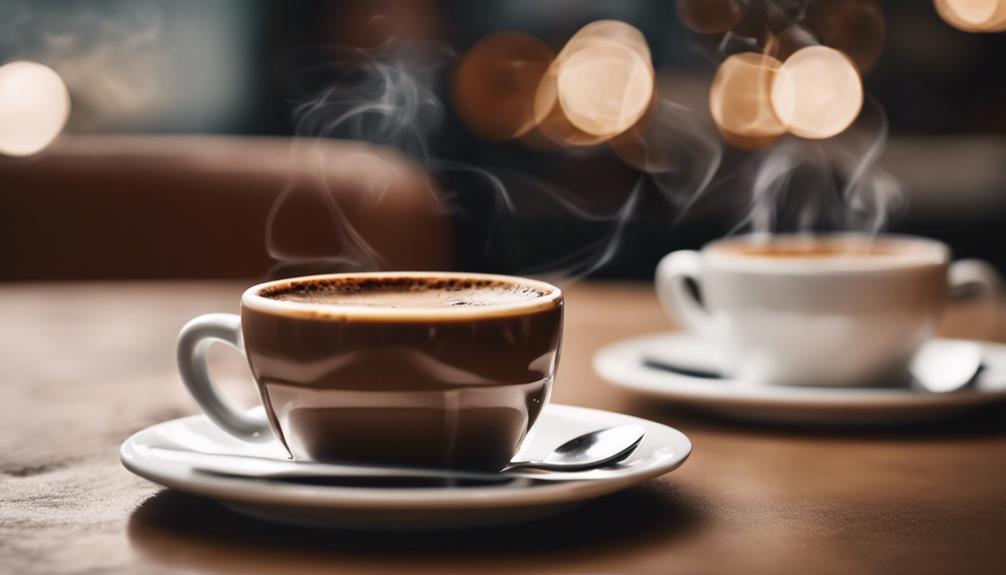
Espresso and lungo differ notably in strength and intensity. Espresso boasts a robust and concentrated flavor profile, appealing to those who crave a bold coffee experience.
On the other hand, lungo offers a milder taste due to its higher water-to-coffee ratio, catering to those who prefer a more balanced coffee flavor.
Flavor Profiles Vary
The strength and intensity of Lungo differ noticeably from Espresso due to their distinct brewing methods and ratios. When comparing the flavor profiles of Lungo and Espresso, you'll notice several key differences:
- Espresso: Offers a bold, intense flavor with rich aroma and thick crema on top.
- Lungo: Provides a milder and more balanced taste with less crema due to its longer extraction time.
- Brew Ratios: Espresso's 1:2 ratio creates a concentrated drink, while Lungo's 1:4 ratio results in a lighter, less intense beverage.
Espresso is renowned for its deep, complex notes and quick extraction process, delivering a dark, viscous appearance. In contrast, Lungo's extended brewing time yields a smoother, more diluted flavor profile, presenting a lighter color and texture. These distinctions cater to varying preferences for coffee strength, allowing coffee enthusiasts to choose based on their desired intensity.
Brewing Methods Differ
Brewing methods play a pivotal role in determining the strength and intensity disparity between Lungo and Espresso. The water-to-coffee ratio and extraction time are key factors influencing the distinct flavors of these two coffee drinks.
Lungo, brewed with about double the water of espresso, results in a milder taste due to its lower coffee concentration. This is achieved through a higher water-to-coffee ratio of 1:4 compared to espresso's 1:2 ratio. Additionally, lungo has a longer extraction time of 30 seconds to 1 minute, allowing for a more gradual flavor extraction process.
In contrast, espresso is known for its bold and concentrated flavor profile, achieved through a quicker extraction time of around 25-30 seconds and a higher pressure brewing method. The combination of these brewing techniques results in espresso's intense taste that differs significantly from the milder flavor of lungo.
Crema Presence
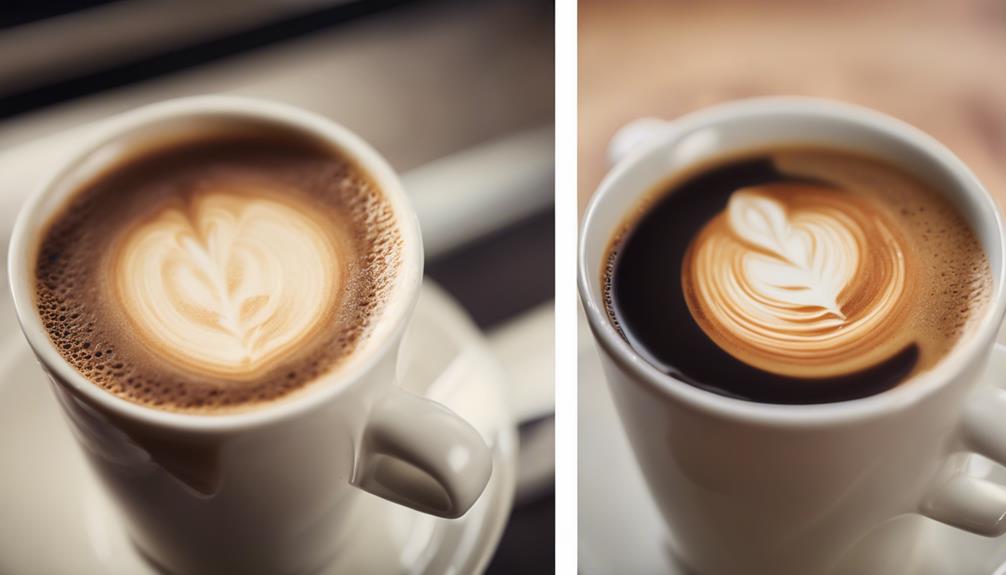
A hallmark of a well-prepared espresso shot is its luscious layer of frothy crema on top. This creamy top not only adds aesthetic appeal but also plays an essential role in enhancing the overall taste experience.
Here's how crema presence differs between espresso and lungo:
- Espresso: Known for its rich and thick layer of crema, espresso showcases the perfect balance of oils and carbon dioxide, resulting in a velvety texture that seals in the coffee's aromas and flavors.
- Lungo: With a longer extraction time and increased water volume, lungo typically has less crema compared to espresso. The lighter crema in lungo may impact the intensity of flavors and the overall mouthfeel of the coffee.
Caffeine Content
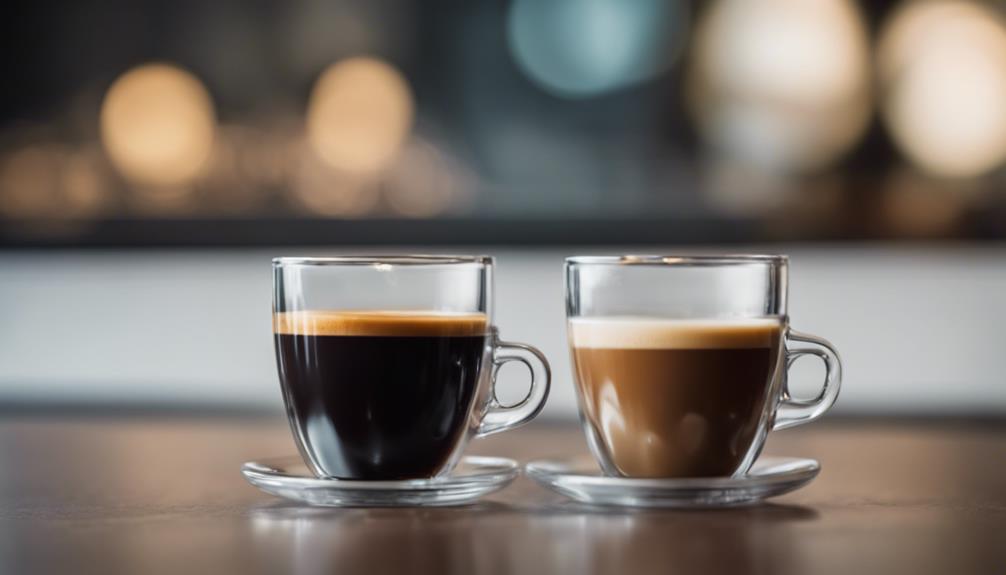
Lungo shots generally pack a higher caffeine punch compared to espresso shots, mainly due to the extended extraction process. The longer brewing time of a lungo allows for a greater amount of caffeine to be extracted from the coffee grounds, resulting in a slightly higher caffeine content.
Understanding these caffeine concentration variances between lungo and espresso can assist you in selecting the ideal coffee option based on your preferred caffeine intake.
Caffeine Concentration Levels
What sets the caffeine concentration levels of lungo and espresso apart? Lungo typically contains more caffeine than espresso due to the longer extraction time, while espresso has a higher concentration of caffeine per ounce compared to lungo.
Here are some key distinctions to take into account:
- Lungo's extended brewing process allows for more caffeine to be extracted from the coffee grounds.
- The caffeine content in espresso is more concentrated and impactful than in lungo.
- Lungo's milder taste compared to espresso doesn't diminish its caffeine content.
Understanding these contrasts can help you choose the coffee that best suits your caffeine preferences. Whether you prefer a stronger, more concentrated caffeine kick from espresso or a milder but caffeine-rich lungo, knowing the caffeine concentration levels of each can guide your coffee selection.
Brewing Method Variances
Understanding the brewing method variances between lungo and espresso can shed light on their caffeine content differences. When brewing a lungo, you use an espresso machine but with double the amount of water compared to making an espresso. This results in a milder taste profile for lungo, as the extended extraction time allows for more caffeine to be extracted from the coffee grounds. On the other hand, espresso is more concentrated in flavor and caffeine content due to its higher brew ratio of coffee to water (1:2) compared to lungo (1:4). The shorter extraction time of espresso leads to a bolder and more intense flavor, making it a favorite for those who enjoy a quick, strong shot of coffee. Here's a comparison of the brewing method variances between lungo and espresso:
| Aspect | Lungo | Espresso |
|---|---|---|
| Water Amount | Double the amount | Standard amount |
| Extraction Time | Longer | Shorter |
| Caffeine Content | More | Concentrated |
Serving Size
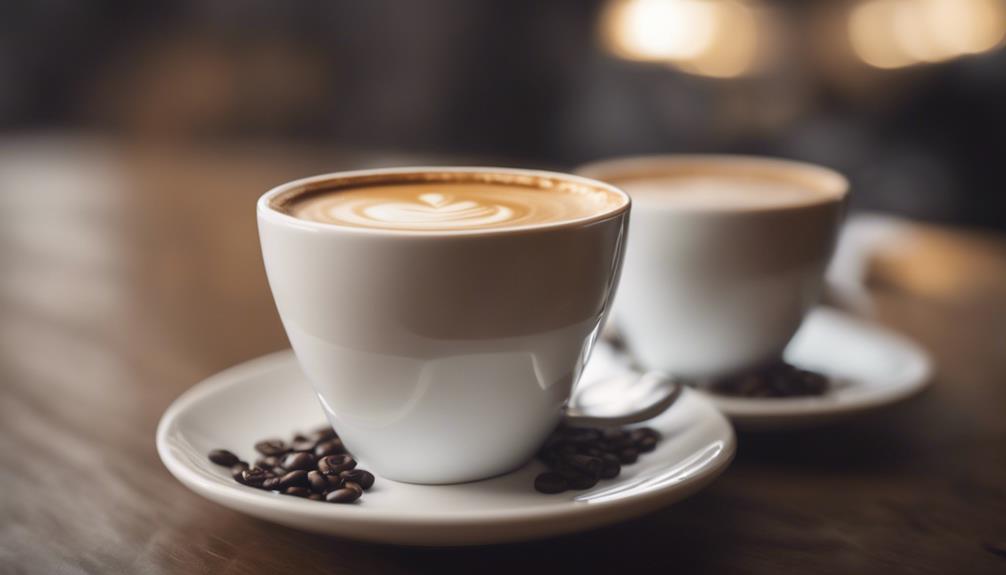
When comparing Lungo and espresso, the serving size plays a significant role in determining the overall taste experience. Here are some key points to take into account:
- A standard espresso shot is about 1 ounce (30ml) in size, delivering a concentrated and intense flavor profile.
- In contrast, Lungo shots are typically larger, measuring up to 110ml, offering a milder taste due to the extended extraction time and larger volume.
- Lungo uses double the amount of water compared to espresso, resulting in a different taste experience despite using the same coffee grounds.
Understanding the serving size differences between Lungo and espresso is essential in choosing a coffee that aligns with your taste preferences. The smaller, potent espresso shot may appeal to those who enjoy strong flavors in a compact serving, while the larger Lungo shot provides a more diluted and smoother taste experience.
Taste Characteristics
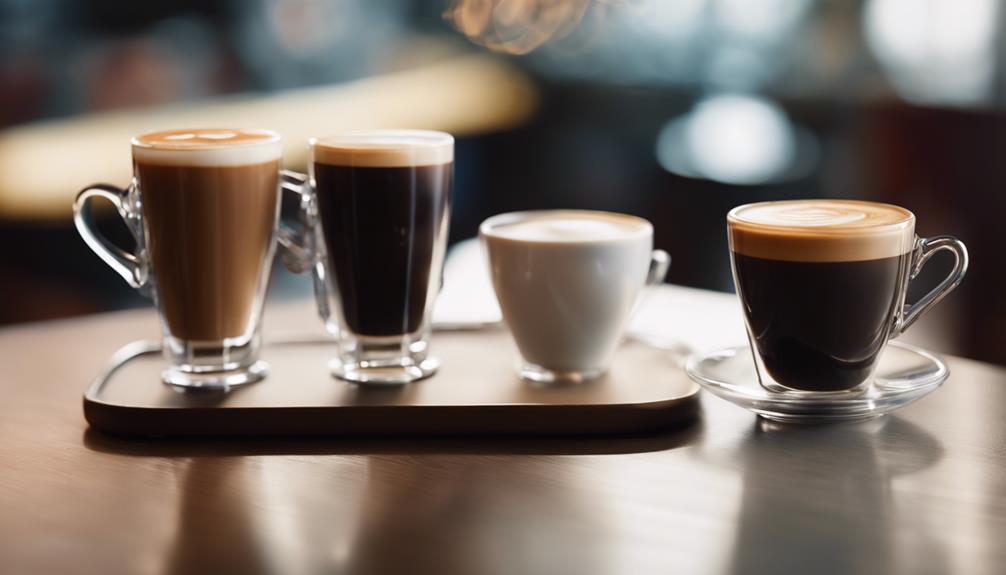
Lungo presents a balanced, mild flavor profile, contrasting with the bold intensity of espresso. The higher water-to-coffee ratio in lungo results in a less intense taste compared to espresso. This brewing method leads to a slight bitterness, as the longer extraction process extracts more compounds from the coffee grounds.
With a brew ratio of 1:4, lungo offers a lighter and more diluted coffee experience, allowing for a smoother flavor profile. The flavors in lungo extract differently compared to espresso, offering a unique coffee-drinking experience. In contrast, espresso is known for its frothy crema and strong taste, providing a more robust and concentrated coffee experience.
The bitter taste in lungo, stemming from the extended extraction, distinguishes it from the intense and bold flavors of espresso. These differences in taste characteristics between lungo and espresso cater to varying preferences for coffee drinkers seeking either a milder or a more intense coffee experience.
Popular Variations
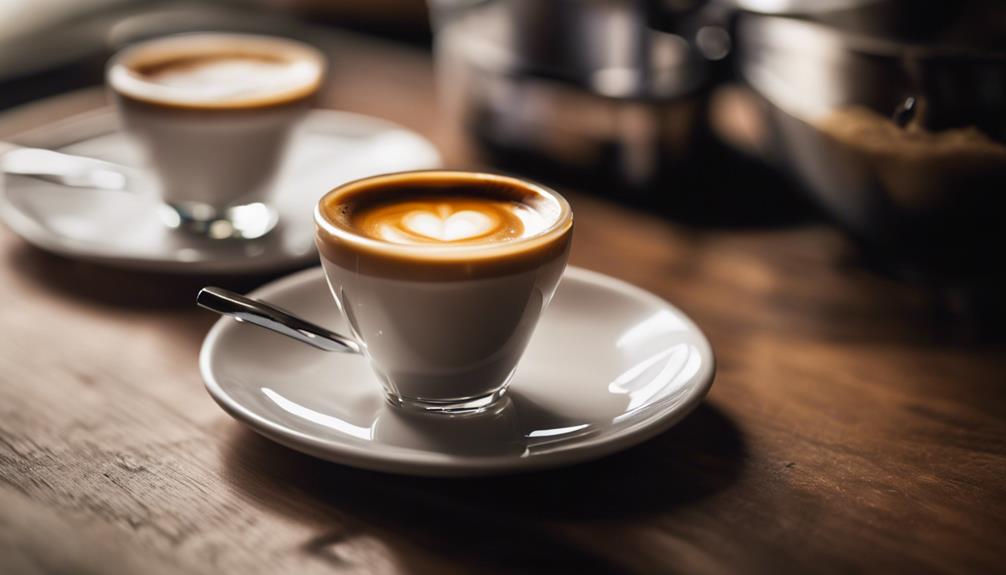
For those exploring the world of coffee variations, delving into popular choices can offer a diverse array of flavors and experiences. When it comes to lungo and espresso variations, each has its unique characteristics that cater to different preferences.
Here are three popular alternatives worth exploring:
- Espresso: Known for its intense and concentrated flavor, espresso is a beloved choice for those seeking a strong coffee experience. With a brew ratio of 1:2, it offers a rich aroma and bold taste that many coffee enthusiasts appreciate.
- Lungo: On the other hand, lungo is a longer espresso variation that uses double the water, resulting in a milder taste profile. With a brew ratio of 1:4, lungo provides a lighter coffee experience compared to espresso, making it an excellent choice for those who prefer a less intense flavor profile.
- Water: The amount of water used in brewing both lungo and espresso plays a significant role in determining the final taste and strength of the coffee. While espresso uses less water, resulting in a more concentrated flavor, lungo's additional water creates a smoother and less intense taste.
Frequently Asked Questions
What Is the Difference Between Lungo and Espresso?
In understanding the difference between lungo and espresso, it's important to recognize their distinct characteristics.
Espresso is a concentrated coffee with a 1:2 brew ratio, boasting a bold flavor and a creamy crema.
On the other hand, lungo is a milder brew, using more water with a 1:4 ratio and offering a balanced taste.
While espresso is around 30ml in volume, lungo can measure up to 110ml, catering to varied preferences in coffee strength and flavor intensity.
Why Is Lungo More Bitter Than Espresso?
When comparing lungo to espresso, lungo tends to be more bitter due to its longer extraction time. The extended contact between water and coffee in lungo can lead to a higher extraction of tannins and bitter compounds from the coffee grounds.
Additionally, the higher water-to-coffee ratio in lungo dilutes the flavors, making the bitterness more pronounced. Factors like grind size, water temperature, and coffee bean quality also play a role in enhancing lungo's bitterness compared to espresso.
What Is the Difference Between Espresso and Ristretto?
Ristretto differs from espresso in its concentrated nature. With a smaller volume of 15-20 ml, ristretto uses the same coffee amount but less water, resulting in a bold and intense flavor profile.
The extraction time for ristretto is shorter than for espresso, enhancing its richness and highlighting both sweet and sour notes in the coffee. This makes ristretto a preferred choice in southern Italy for those seeking a robust coffee experience.
What Is the Difference Between Espresso Lungo and Espresso Macchiato?
When comparing espresso lungo and espresso macchiato, it's like differentiating between a leisurely stroll and a quick sprint. Espresso lungo is a longer and milder coffee, with a higher water-to-coffee ratio, offering a balanced flavor.
On the other hand, espresso macchiato is a bolder, more concentrated drink, with a shot of espresso 'stained' with a hint of milk foam. Each has its distinct characteristics, catering to different preferences and tastes.
What is the main difference between Lungo and Espresso?
Lungo and Espresso differ in their shot size. Lungo is a long shot of espresso made with double the amount of water, while a single vs double shot espresso refers to the amount of espresso used. Lungo has a larger volume and milder flavor, while Espresso is more intense and concentrated.
Conclusion
In the world of coffee, the differences between lungo and espresso go beyond just brewing methods and taste. They represent two distinct experiences, with lungo symbolizing a longer, milder journey and espresso embodying a short, intense burst of flavor.
Understanding these key differences can help you appreciate the nuances of each brew and choose the one that best suits your preferences. So whether you crave a leisurely sip or a quick pick-me-up, there's a coffee for every moment.
